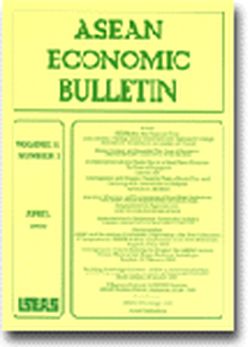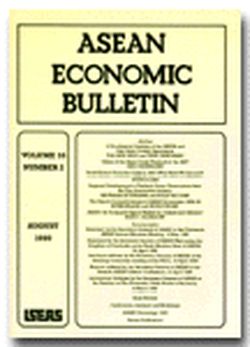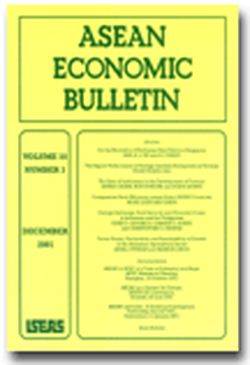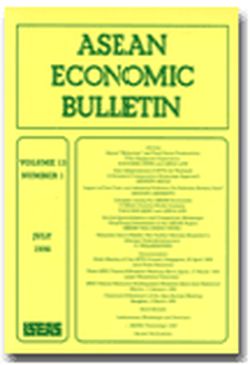ASEAN Economic Bulletin Vol. 19/2 (Aug 2002)

Date of publication:
September 2002
Number of pages:
108
Code:
AE19/2
Contents
-
ASEAN Economic Bulletin Vol. 19/2 (Aug 2002)
-
Preliminary pages.
- ARTICLES
-
New Regionalism in East Asia: How Does it Relate to the East Asian Economic Development Model?, by Charles Harvie, Lee Hyun-Hoon, authors see abstractSince the 1997-98 financial crisis, a new regionalism has emerged in East Asia that represents a clear break from the region's strong history of multilateralism. This article reviews recent movements towards regionalism in East Asia, discusses how this relates to the region's economic development model, and analyses its ability to revive dynamic regional economic growth that was enjoyed over a period of thirty years until the onset of the financial crisis in 1997. In doing so, we first summarize the key features of the "old" East Asian Development Model (EADM), and then present an interpretation of the emerging features of the "new" economic model emphasizing the rapidly changing external environment. The need for expanded intra-regional economic co-operation among the economies of East Asia is given particular emphasis.
-
International R&D Spillovers and Trade Expansion: Evidence from East Asian Economies, by Misa Okabe, author see abstractThe purpose of this article is to empirically investigate how the Research and Development (R&D) capital formation in developed countries affects the productivity of East Asian economies. Using a data set of seven East Asian economies (Hong Kong, Indonesia, Korea, Malaysia, the Philippines, Singapore and Thailand), it is found that the international R&D spillovers from OECD countries promote the total factor productivity (TFP) of sample economies. Moreover, the results show that the international R&D spillovers correlate with international trade, particularly with manufacturing goods imports. It follows from these results that the process of economic growth in East Asian economies has accompanied the international R&D spillovers through international trade expansion.
-
Services and Economic Growth in ASEAN Economies, by Azmat Gani, Michael D Clemes, authors see abstractThis article presents an empirical study of the determinants of per capita economic growth in the group of economies forming ASEAN using data from 1965 to 1994. Particular attention is paid to the contribution of services to the growth of real GDP per capita. Estimation results of a structural per capita growth equation reveal that growth of services exerts a statistically significant positive effect. In addition, the results confirm strong a positive influence of growth in manufacturing and government spending on service sector expansion. Furthermore, services also have a spillover effect on manufacturing.
-
The Viability of Fiscal Policy in South Korea, Taiwan, and Thailand, by Tsangyao Chang, Wen Rong Liu, Henry Thompson, authors see abstractThe viability of stimulative fiscal policy has become a political issue in South Korea, Taiwan, and Thailand since the Asian financial crisis of 1997. This article examines historical relationships between government spending, taxes, and output in these countries using co-integration and vector auto-regression techniques with data starting in the 1950s. South Korea has had a policy of spend-and-tax, Taiwan tax-and-spend, while in Thailand there has been no apparent approach to fiscal policy. For the three countries, fiscal policy has had zero to negligible effects on output and is not recommended as a way to stimulate output.
-
Is There a Real TFP Growth Measure for Malaysias Manufacturing Industries?, by Renuka Mahadevan, author see abstractThe existence of a "real" or accurate total factor productivity (TFP) growth measure is discussed and questioned by comparing TFP growth measures from a parametric and nonparametric frontier model using a panel data of twenty-eight manufacturing industries from 1981 to 1996. The discussion is then enhanced by the decomposition of TFP growth from the two frontier models into technical change and change in technical efficiency. In this way, the identification of the sources of TFP growth allows for more accurate policy implications for sustainable growth. The results are also compared with previous studies for robustness.
-
Temporal Causality between the Malaysian Stock Price and Stock-indexed Futures Market amidst the Selective Capital Controls Regime, by Tan Juat Hong, author see abstractThe article examines the temporal causal relationships between Malaysian stock prices measured by the composite index (MSCI) and stock-indexed futures prices (KLFI), with the aid of co-integration and error correction modelling. The empirical regressions from standard Granger causality and Hsiao's sequential approach (HSM) suggest a bi-directional (feedback) causality for the short-run period; while the error correction method (ECM) provides the evidence that the stock index futures (KLFI) leads the market stock (composite) index (MSCI). The selective capital controls policy does have a positive influence on the stock-indexed futures market.
-
DOCUMENTATION: Globalizations Challenge to Regional Economic Integration. Address of Rodolfo C. Severino, Secretary-General of the Association of Southeast Asian Nations, at the Symposium on AFTA and Beyond, Manila, 30 May 2002
-
DOCUMENTATION: ASEAN and Germany Natural Partners. Address by Rodolfo C. Severino, Secretary-General of the Association of Southeast Asian Nations, before the Deutsches Forum Jakarta, Jakarta, 30 April 2002
-
DOCUMENTATION: The ASEAN Free Trade Area: Reaching its Target. Opening remarks of Rodolfo C. Severino, Secretary-General of the Association of Southeast Asian Nations, at the AFTA 2002 Symposium, Jakarta, 31 January 2002
-
BOOK REVIEW: Rethinking the East Asian Miracle, edited by Joseph E. Stiglitz and Shahid Yusuf, by Denis Hew Wei-Yen, author
-
BOOK REVIEW: Rethinking Development in East Asia: From Illusory Miracle to Economic Crisis, edited by Pietro P. Masina, by William E Worner, author
-
BOOK REVIEW: Productivity and Economic Performance in the Asia-Pacific Region, edited by Tsu-Tan Fu, Cliff J. Huang, and C. A. Knox Lovell, by Renuka Mahadevan, author
-
BOOK REVIEW: Financial Big Bang in Asia, edited by Masayoshi Tsurumi, by Sakulrat Montreevat, author
-
BOOK REVIEW: International Production Networks in Asia: Rivalry or Riches?, edited by Michael Borrus, Dieter Ernst, and Stephan Haggard, by Nick J Freeman, author
-
BOOK REVIEW: Intangibles in Competition and Cooperation: Euro-Asian Perspectives, edited by Parthasarathi Banerjee and Frank-Jrgen Richter, by Dimitrios Konstadakopulos, author
-
BOOK REVIEW: Malaysian Eclipse: Economic Crisis and Recovery, edited by K. S. Jomo, by Arnab Gupta, author






